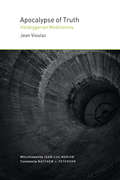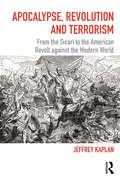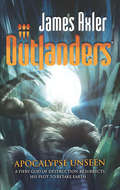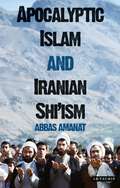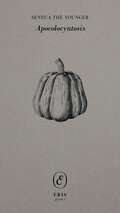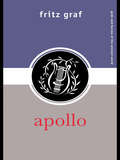- Table View
- List View
Apocalypse of Truth: Heideggerian Meditations
by Jean VioulacWe inhabit a time of crisis—totalitarianism, environmental collapse, and the unquestioned rule of neoliberal capitalism. Philosopher Jean Vioulac is invested in and worried by all of this, but his main concern lies with how these phenomena all represent a crisis within—and a threat to—thinking itself. In his first book to be translated into English, Vioulac radicalizes Heidegger’s understanding of truth as disclosure through the notion of truth as apocalypse. This “apocalypse of truth” works as an unveiling that reveals both the finitude and mystery of truth, allowing a full confrontation with truth-as-absence. Engaging with Heidegger, Marx, and St. Paul, as well as contemporary figures including Giorgio Agamben, Alain Badiou, and Slavoj Žižek, Vioulac’s book presents a subtle, masterful exposition of his analysis before culminating in a powerful vision of “the abyss of the deity.” Here, Vioulac articulates a portrait of Christianity as a religion of mourning, waiting for a god who has already passed by, a form of ever-present eschatology whose end has always already taken place. With a preface by Jean-Luc Marion, Apocalypse of Truth presents a major contemporary French thinker to English-speaking audiences for the first time.
Apocalypse, Revolution and Terrorism: From the Sicari to the American Revolt against the Modern World (Political Violence)
by Jeffrey KaplanThis book focuses on religiously driven oppositional violence through the ages. Beginning with the 1st-century Sicari, it examines the commonalities that link apocalypticism, revolution, and terrorism occurring in Judaism, Christianity, and Islam past and present. It is divided into two sections, 'This was Then' and 'This is Now', which together examine the cultural and religious history of oppositional violence from the time of Jesus to the aftermath of the 2016 American election. The historical focus centers on how the movements, leaders and revolutionaries from earlier times are interpreted today through the lenses of historical memory and popular culture. The radical right is the primary but not exclusive focus of the second part of the book. At the same time, the work is intensely personal, in that it incorporates the author's experiences in the worlds of communist Eastern Europe, in the Iranian Revolution, and in the uprisings and wars in the Middle East and East Africa. This book will be of much interest to students of religious and political violence, religious studies, history, and security studies.
Apocalypse, Revolution and Terrorism: From the Sicari to the American Revolt against the Modern World (Political Violence)
by Jeffrey KaplanThis book focuses on religiously driven oppositional violence through the ages. Beginning with the 1st-century Sicari, it examines the commonalities that link apocalypticism, revolution, and terrorism occurring in Judaism, Christianity, and Islam past and present. It is divided into two sections, 'This was Then' and 'This is Now', which together examine the cultural and religious history of oppositional violence from the time of Jesus to the aftermath of the 2016 American election. The historical focus centers on how the movements, leaders and revolutionaries from earlier times are interpreted today through the lenses of historical memory and popular culture. The radical right is the primary but not exclusive focus of the second part of the book. At the same time, the work is intensely personal, in that it incorporates the author's experiences in the worlds of communist Eastern Europe, in the Iranian Revolution, and in the uprisings and wars in the Middle East and East Africa. This book will be of much interest to students of religious and political violence, religious studies, history, and security studies.
Apocalypses: Prophecies, Cults And Millennial Beliefs Throughout The Ages
by Eugene WeberIn these secular times, confessing to a belief in the apocalypse consigns a person to Christian fundamentalism or to cult status. But for centuries the Judaeo-Christian version of apocalypse - its Revelations-driven belief in the destruction of evil and the Second Coming of Christ - was accepted as the literal truth and ultimate destination of human existence. The distinguished historian Eugen Weber redresses the historical and religious amnesia that has consigned the study of apocalyptic and millennial thought to the lunatic fringe. Elegantly written, as witty and entertaining as its profound, this is more a travel book of the apocalypse than a definitive academic treatment. And at its heart is a profound respect for the resilience of alternative rationalities, and for the luxuriant current growth of millenarianism in Africa, Asia and South America.
Apocalyptic Anxiety: Religion, Science, and America's Obsession with the End of the World
by Anthony AveniApocalyptic Anxiety traces the sources of American culture’s obsession with predicting and preparing for the apocalypse. Author Anthony Aveni explores why Americans take millennial claims seriously, where and how end-of-the-world predictions emerge, how they develop within a broader historical framework, and what we can learn from doomsday predictions of the past. The book begins with the Millerites, the nineteenth-century religious sect of Pastor William Miller, who used biblical calculations to predict October 22, 1844 as the date for the Second Advent of Christ. Aveni also examines several other religious and philosophical movements that have centered on apocalyptic themes—Christian millennialism, the New Age movement and the Age of Aquarius, and various other nineteenth- and early twentieth-century religious sects, concluding with a focus on the Maya mystery of 2012 and the contemporary prophets who connected the end of the world as we know it with the overturning of the Maya calendar. Apocalyptic Anxiety places these seemingly never-ending stories of the world’s end in the context of American history. This fascinating exploration of the deep historical and cultural roots of America’s voracious appetite for apocalypse will appeal to students of American history and the histories of religion and science, as well as lay readers interested in American culture and doomsday prophecies.
Apocalyptic Bodies: The Biblical End of the World in Text and Image
by Tina PippinApocalyptic Bodies traces the biblical notions of the end of the world as represented in ancient and modern texts, art, music and popular culture, for example the paintings of Bosch. Tina Pippin addresses the question of how far we, in the late twentieth century, are capable of reading and responding to the 'signs of the times'. It will appeal not only to those studying religion, but also to those fascinated with interpretations of the end of the world.
Apocalyptic Bodies: The Biblical End of the World in Text and Image
by Tina PippinApocalyptic Bodies traces the biblical notions of the end of the world as represented in ancient and modern texts, art, music and popular culture, for example the paintings of Bosch. Tina Pippin addresses the question of how far we, in the late twentieth century, are capable of reading and responding to the 'signs of the times'. It will appeal not only to those studying religion, but also to those fascinated with interpretations of the end of the world.
Apocalyptic California: Gender in Climate Fiction
by MaryKate MessimerThis book explores concepts of environmentalism and feminism in science fiction novels written by women. By extrapolating the future of climate change, the authors of these texts model how readers can apply utopian feminist and environmental theories in their own lives. Chapter One establishes an understanding of ecofeminist environmental thinking through original research conducted at the Ursula K. Le Guin archive at the University of Oregon. Chapter Two shows an example of climate change dystopia set in California in Claire Vaye Watkins’ novel Gold Fame Citrus. The final chapters explore utopian visions of queer ecologies in books by Octavia Butler and N.K. Jemisin. Because climate change is so difficult for individuals to grapple with, a new perspective is needed to survive it. The queer ecological philosophy in these novels points to a way of life that can reduce environmental harm in an era of climate change.
Apocalyptic Geographies: Religion, Media, and the American Landscape
by Jerome TharaudHow nineteenth-century Protestant evangelicals used print and visual media to shape American cultureIn nineteenth-century America, "apocalypse" referred not to the end of the world but to sacred revelation, and "geography" meant both the physical landscape and its representation in printed maps, atlases, and pictures. In Apocalyptic Geographies, Jerome Tharaud explores how white Protestant evangelicals used print and visual media to present the antebellum landscape as a “sacred space” of spiritual pilgrimage, and how devotional literature influenced secular society in important and surprising ways.Reading across genres and media—including religious tracts and landscape paintings, domestic fiction and missionary memoirs, slave narratives and moving panoramas—Apocalyptic Geographies illuminates intersections of popular culture, the physical spaces of an expanding and urbanizing nation, and the spiritual narratives that ordinary Americans used to orient their lives. Placing works of literature and visual art—from Thomas Cole’s The Oxbow to Harriet Beecher Stowe’s Uncle Tom’s Cabin and Henry David Thoreau’s Walden—into new contexts, Tharaud traces the rise of evangelical media, the controversy and backlash it engendered, and the role it played in shaping American modernity.
Apocalyptic Geographies: Religion, Media, and the American Landscape
by Jerome TharaudHow nineteenth-century Protestant evangelicals used print and visual media to shape American cultureIn nineteenth-century America, "apocalypse" referred not to the end of the world but to sacred revelation, and "geography" meant both the physical landscape and its representation in printed maps, atlases, and pictures. In Apocalyptic Geographies, Jerome Tharaud explores how white Protestant evangelicals used print and visual media to present the antebellum landscape as a “sacred space” of spiritual pilgrimage, and how devotional literature influenced secular society in important and surprising ways.Reading across genres and media—including religious tracts and landscape paintings, domestic fiction and missionary memoirs, slave narratives and moving panoramas—Apocalyptic Geographies illuminates intersections of popular culture, the physical spaces of an expanding and urbanizing nation, and the spiritual narratives that ordinary Americans used to orient their lives. Placing works of literature and visual art—from Thomas Cole’s The Oxbow to Harriet Beecher Stowe’s Uncle Tom’s Cabin and Henry David Thoreau’s Walden—into new contexts, Tharaud traces the rise of evangelical media, the controversy and backlash it engendered, and the role it played in shaping American modernity.
An Apocalyptic History of the Early Fatimid Empire (Edinburgh Studies in Islamic Apocalypticism and Eschatology)
by Jamel VeljiHow can religion transform a society? This book investigates the ways in which a medieval Islamic movement harnessed Quranic visions of utopia to construct one of the most brilliant and lasting empires in Islamic history (979-1171). The Fatimids’ apocalyptic vision of their central place in an imminent utopia played a critical role in transfiguring the intellectual and political terrains of North Africa in the early tenth century. Yet the realities that they faced on the ground often challenged their status as the custodians of a pristine Islam at the end of time. Through a detailed examination of some of the structural features of the Fatimid revolution, as well as early works of ta'wil, or symbolic interpretation, Jamel Velji illustrates how the Fatimids conceived of their mission as one that would bring about an imminent utopia. He then examines how the Fatimids reinterpreted their place in history when the expected end never materialised. The book ends with an extensive discussion of another apocalyptic event linked to a Fatimid lineage: the Nizari Ismaili declaration of the end of time on August 8, 1164.
An Apocalyptic History of the Early Fatimid Empire (Edinburgh Studies in Islamic Apocalypticism and Eschatology)
by Jamel VeljiHow can religion transform a society? This book investigates the ways in which a medieval Islamic movement harnessed Quranic visions of utopia to construct one of the most brilliant and lasting empires in Islamic history (979-1171). The Fatimids’ apocalyptic vision of their central place in an imminent utopia played a critical role in transfiguring the intellectual and political terrains of North Africa in the early tenth century. Yet the realities that they faced on the ground often challenged their status as the custodians of a pristine Islam at the end of time. Through a detailed examination of some of the structural features of the Fatimid revolution, as well as early works of ta'wil, or symbolic interpretation, Jamel Velji illustrates how the Fatimids conceived of their mission as one that would bring about an imminent utopia. He then examines how the Fatimids reinterpreted their place in history when the expected end never materialised. The book ends with an extensive discussion of another apocalyptic event linked to a Fatimid lineage: the Nizari Ismaili declaration of the end of time on August 8, 1164.
Apocalyptic Islam and Iranian Shi'ism
by Abbas AmanatInterest in Shi'i Islam is running at unprecedented levels. International tensions over Iran, where the largest number of Shi'i Muslims live, as well as the political resurgence of the Shi'i in Iraq and Lebanon, have created an urgent need to understand the background, beliefs and motivations of this dynamic vision of Islam. Abbas Amanat is one of the leading scholars of Shi'ism. And in this powerful book, a showcase for some of his most influential writing in the field, he addresses the colourful and diverse history of Shi' Islam in both premodern and contemporary times.Focusing specifically on the importance of apocalypticism in the development of modern Shi'i theology, he shows how an immersion in messianic ideas has shaped the conservative character of much Shi'i thinking, and has prevented it from taking a more progressive course. Tracing the continuity of apocalyptic trends from the Middle Ages to the present, Amanat addresses such topics as the early influence on Shi'ism of Zoroastrianism; manifestations of apocalyptic ideology during the Iranian Revolution of 1979; and the rise of the Shi'i clerical establishment during the 19th and 20th centuries.His book will be an essential resource for students and scholars of both religious studies and Middle Eastern history.
Apocalyptic Movements in Contemporary Politics: Christian and Jewish Zionism
by C. AldrovandiThis book explores Israeli Religious Zionism and US Christian Zionism by focusing on the Messianic and Millenarian drives at the basis of their political mobilization towards a 'Jewish colonization' of the occupied territories.
The Apocalyptic Year 1000: Religious Expectaton and Social Change, 950-1050
by Richard Landes Andrew Gow David Van MeterThe essays in this book challenge prevailing views on the way in which apocalyptic concerns contributed to larger processes of social change at the first millennium. Several basic questions unify the essays: What chronological and theological assumptions underlay apocalyptic and millennial speculations around the Year 1000? How broadly disseminated were those speculations? Can we speak of a mentality of apocalyptic hopes and anxieties on the eve of the millennium? If so, how did authorities respond to or even contribute to the formation of this mentality? What were the social ramifications of apocalyptic hopes and anxieties, and of any efforts to suppress or redirect the more radical impulses that bred them? How did contemporaries conceptualize and then historicize the passing of the millennial date of 1000? Including the work of British, French, German, Dutch, and American scholars, this book will be the definitive resource on this fascinating topic, and should at the same time provoke new interest in and debate on the nature and causes of social change in early medieval Europe.
Apocalypticism, Anti-Semitism and the Historical Jesus: Subtexts in Criticism (The Library of New Testament Studies #275)
by John S. Kloppenborg John MarshallVirtually all scholars agree that apocalyptic and millenarianism formed at least part of the matrix of the culture in first-century Jewish Palestine, but there is a sharp disagreement concerning the extent to which Jesus shared apocalyptic and millenarian beliefs. Although there has been a great deal written defending or opposing an 'apocalyptic Jesus', almost nothing has been said on the questions of what, from the standpoint of modern historiography of Jesus, is at stake in the issue of whether or not he was an apocalypticist or a millenarian prophet, and what is at stake in arguing that his alleged apocalypticism is a central and defining characteristic, rather than an incidental feature. Much has been said on the kind of Jew Jesus was, but almost nothing is said on why the category of Judaism has become so central to historical Jesus debates. These questions have less to do with the quantity and character of the available ancient evidence than they do with the ways in which the modern critic assembles evidence into a coherent picture, and the ideological and theological subtexts of historical Jesus scholarship. Scholars of Christian origins have been rather slow to inquire into the ideological location of their own work as scholars, but it is this question that is crucial in achieving a critical self-awareness of the larger entailments of historical scholarship on Jesus and the early Jesus movement. This volume begins the inquiry into the ideological location of modern historical Jesus scholarship.JSHJ, JSNTS275
Apocalypticism in the Dead Sea Scrolls (The Literature of the Dead Sea Scrolls)
by John J. CollinsSince the photographs of the Dead Sea Scrolls were released in 1992, there has been an explosion of interest in them. This volume explores the issue of apocalypticism in the Scrolls; how the notions of the 'end', Messianic expectation and eternal life affected the Dead Sea sect, influenced Judaism and filtered into Christianity. Collins' volume provides a valuable and accessible introduction to the interpretation of the Scrolls, which is an informative addition to the series examining the major themes of the Scroll texts.
Apocalypticism in the Dead Sea Scrolls (The Literature of the Dead Sea Scrolls)
by John J. CollinsSince the photographs of the Dead Sea Scrolls were released in 1992, there has been an explosion of interest in them. This volume explores the issue of apocalypticism in the Scrolls; how the notions of the 'end', Messianic expectation and eternal life affected the Dead Sea sect, influenced Judaism and filtered into Christianity. Collins' volume provides a valuable and accessible introduction to the interpretation of the Scrolls, which is an informative addition to the series examining the major themes of the Scroll texts.
Apocolocyntosis: or Ludus de morte Claudii: The Pumpkinification of Claudius (ERIS Gems)
by Seneca"I know the same day made me free, which was the last day for him who made the proverb true—One must be born either a Pharaoh or a fool".Best known as a philosopher and tragedian, in Apocolocyntosis Seneca also produced one of classical literature's greatest satires. Depicting a posthumous trial in which the recently deceased Emperor Claudius makes the case for his elevation to the company of the gods, this short work brilliantly skewers the pretensions and corruptions of power.
The Apocrypha: A Guide (Guides to Sacred Texts)
by Matthew GoffMany readers of scripture, particularly in North America, are not aware that a substantial number of books were removed from their Old Testament. These books, often known collectively as the Apocrypha, were considered scripture for centuries and for millions of Christians today still are. This book is an introduction to the Apocrypha. It discusses ancient and early modern disputes about scripture to provide context for understanding the formation of the textual category "Apocrypha." Each chapter focuses on a specific book, examining its core themes and ideas. The cultural and historical context of the composition of each book is analyzed in its ancient Jewish milieu. This historical context is often elucidated by the Dead Sea Scrolls which have only in recent years been published in full. The later reception of this material in rabbinic Judaism, Christianity, and other modern cultural contexts such as art and literature, is also discussed. This book is designed to be read along with the texts of the Apocrypha themselves, as presented in the New Oxford Annotated Bible. The present volume is written not primarily for scholars but rather for anyone who would like to learn more about the Apocrypha. This book was shaped by an overarching conviction-that people who know next to nothing about the writings covered in this volume would enjoy reading them. If you have heard something about the books of the Apocrypha and want to know more about them, this book is for you.
The Apocrypha: A Guide (Guides to Sacred Texts)
by Matthew GoffMany readers of scripture, particularly in North America, are not aware that a substantial number of books were removed from their Old Testament. These books, often known collectively as the Apocrypha, were considered scripture for centuries and for millions of Christians today still are. This book is an introduction to the Apocrypha. It discusses ancient and early modern disputes about scripture to provide context for understanding the formation of the textual category "Apocrypha." Each chapter focuses on a specific book, examining its core themes and ideas. The cultural and historical context of the composition of each book is analyzed in its ancient Jewish milieu. This historical context is often elucidated by the Dead Sea Scrolls which have only in recent years been published in full. The later reception of this material in rabbinic Judaism, Christianity, and other modern cultural contexts such as art and literature, is also discussed. This book is designed to be read along with the texts of the Apocrypha themselves, as presented in the New Oxford Annotated Bible. The present volume is written not primarily for scholars but rather for anyone who would like to learn more about the Apocrypha. This book was shaped by an overarching conviction-that people who know next to nothing about the writings covered in this volume would enjoy reading them. If you have heard something about the books of the Apocrypha and want to know more about them, this book is for you.
The Apocryphal Gospels
by Simon GathercoleA new translation of the oldest non-canonical Christian gospels In the early years of Christianity, several groups produced 'hidden' or 'apocryphal' gospels, alternative versions of the story of Christ. Sometimes these texts complemented the four canonical gospels of the New Testament, sometimes they subverted them and often they were completely different. Here, in the widest selection of non-canonical gospels gathered in one volume - which also includes two modern forgeries - we see the young Jesus making live birds from clay, hear his secret words of wisdom, discover gnostic cosmologies and witness the Harrowing of Hell. Preserved by their readers and attacked by their detractors, these gospels shine a fascinating light on the early Christian Church.Translated with an Introduction by Simon Gathercole'This will become the standard version both for the general reader and for scholars.'John Barton, author of A History of the Bible
Apogee of Empire: Spain and New Spain in the Age of Charles III, 1759–1789
by Stanley J. Stein Barbara H. SteinOnce Europe's supreme maritime power, Spain by the mid-eighteenth century was facing fierce competition from England and France. England, in particular, had successfully mustered the financial resources necessary to confront its Atlantic rivals by mobilizing both aristocracy and merchant bourgeoisie in support of its imperial ambitions. Spain, meanwhile, remained overly dependent on the profits of its New World silver mines to finance both metropolitan and colonial imperatives, and England's naval superiority constantly threatened the vital flow of specie.When Charles III ascended the Spanish throne in 1759, then, after a quarter-century as ruler of the Kingdom of the Two Sicilies, Spain and its colonial empire were seriously imperiled. Two hundred years of Hapsburg rule, followed by a half-century of ineffectual Bourbon "reforms," had done little to modernize Spain's increasingly antiquated political, social, economic, and intellectual institutions. Charles III, recognizing the pressing need to renovate these institutions, set his Italian staff—notably the Marqués de Esquilache, who became Secretary of the Consejo de Hacienda (the Exchequer)—to this formidable task.In Apogee of Empire, Stanley J. Stein and Barbara H. Stein trace the attempt, initially under Esquilache's direction, to reform the Spanish establishment and, later, to modify and modernize the relationship between the metropole and its colonies. Within Spain, Charles and his architects of reform had to be mindful of determining what adjustments could be made that would help Spain confront its enemies without also radically altering the Hapsburg inheritance. As described in impressive detail by the authors, the bitter, seven-year conflict that ensued between reformers and traditionalists ended in a coup in 1766 that forced Charles to send Esquilache back to Italy. After this setback at home, Charles still hoped to effect constructive change in Spain's imperial system, primarily through the incremental implementation of a policy of comercio libre (free-trade). These reforms, made half-heartedly at best, failed as well, and by 1789 Spain would find itself ill prepared for the coming decades of upheaval in Europe and America.An in-depth study of incremental response by an old imperial order to challenges at home and abroad, Apogee of Empire is also a sweeping account of the personalities, places, and policies that helped to shape the modern Atlantic world.
Apollo (Gods and Heroes of the Ancient World)
by Fritz GrafFritz Graf here presents a survey of a god once thought of as the most powerful of gods, and capable of great wrath should he be crossed: Apollo the sun god. From his first attestations in Homer, through the complex question of pre-Homeric Apollo, to the opposition between Apollo and Dionysos in nineteenth and twentieth-century thinking, Graf examines Greek religion and myth to provide a full account of Apollo in the ancient world. For students of Greek religion and culture, of myth and legend, and in the fields of art and literature, Apollo will provide an informative and enlightening introduction to this powerful figure from the past.
